[Editor’s note: The Kitasoo Xai’xais First Nation reviewed this article before publication as part of a collaborative journalism practice.]
Champagne-coloured herring eggs cover every surface. They coat the feathery hemlock branches and long, rubbery blades of kelp the fishers pull out of the icy early-April waters. They’re piled high on the blue tarp spread out over the bottom of the small tin boat and they’re stuck to the knees, elbows and ruddy fingers of the fishers, who lie on their bellies to reach over the edge of the boat to harvest the eggs. Every step brings a tiny crackle as scattered sesame seed-sized roe pop beneath your boots.
This is the herring roe harvest in Gitdisdzu Lugyeks, or Kitasu Bay, where the Kitasoo Xai’xais Nation harvest 95 per cent of the herring roe for people living in Klemtu, a remote community of 350 people on British Columbia’s Central Coast.
You watch the moon to know when the herring will spawn, says Kitasoo Xai’xais Elder and Hereditary Chief Haay-maas, whose English name is Ernst V. Mason Jr., and whose nickname is Charlie. The moon’s crescent “tips” over like a cup; when it looks like it’s ready to pour out, the herring will arrive by the millions and spawn, tipping sideways as they spill their milt, or seminal fluid, across large stretches of the coast. The milt stains the ocean a pale milky colour, like spilt moonlight.
A couple days before the herring spawn Kitasoo Xai’xais fishers collect hemlock and kelp and lower them into the ocean below the low-tide line, weighing them down with fist-sized rocks and marking them with worn styrofoam buoys.
No more than four days after the spawn, fishers return, pulling the now roe-encrusted branches and kelp from the deep. They use hooks, rope and their hands to hold their harvest at the surface and sheers to trim boughs off. The boughs are dipped once more in the ocean and laid on the tarp.

The eggs are lightly salty and umami, crackling as you bite into a clump. Eating roe off a hemlock branch adds a citrusy, almost sweet flavour.
Protecting the harvest
Indigenous harvesters have been pulling herring roe-coated hemlock branches out of these waters every spring for thousands of years. During that time they were learning how to manage these ecosystems, stewarding the lands and waters. This didn’t change after colonization — the Kitasoo Xai’xais never ceded territory through treaty to colonial governments.
Herring stocks have been in steep decline over the last 100 years, leading some to declare the fishery “collapsed.”
Last year Kitasoo Xai’xais Hereditary Chiefs didn’t allow any community harvest because the spawn was so small. Along the coast Fisheries and Oceans Canada has also closed fisheries for years on end due to low stocks.
The species decline is in part due to the way the fish is harvested. The majority of commercial herring harvest captures the fish, guts them to harvest the eggs and then turns their bodies into food for fish farms, captured whales or pet food.
To harvest their herring roe, the Kitasoo Xai’xais participate in the spawn on kelp fishery, which collects the eggs but does not kill the fish.
To protect what is left the Heiltsuk First Nation have prohibited commercial herring harvest in their territory, the Nuu-chah-nulth have successfully fought to keep the fishery closed on the west coast of Vancouver Island and now the Kitasoo Xai’xais have closed Kitasoo Bay.
They did this by declaring Kitasu Bay a Marine Protected Area in the summer of 2022, in a decision made by the nation’s Hereditary Chiefs and supported by the elected Chief and council.
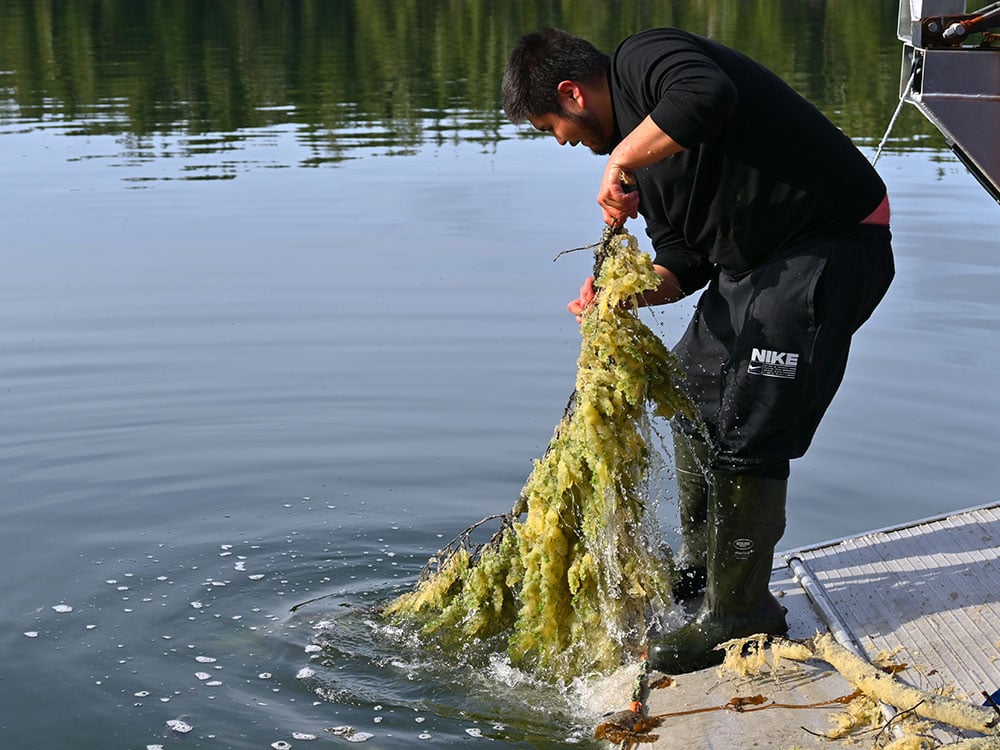
“We make this declaration in accordance with Kitasoo Xai’xais laws, customs, principles and values and as the holders of inherent and Aboriginal Rights and Title on our unceded territorial lands and waters,” the declaration reads. “Our laws include our inherent stewardship responsibilities to act in a manner that protects this unique place on behalf of past, current and future generations of Kitasoo Xai’xais.”
Alongside the declaration, the nation published a management plan defining what economic activities are and are not allowed to happen in the 33.5 acre bay.
It's a management plan thousands of years in the making, that combines the experience, knowledge, research and monitoring of their ancestors, 20 years of modern land and marine management planning, laws and stewardship practices passed down through their stories, songs, names and practices and guided by legal principles which they have followed for thousands of years. These include łoomsk (respect), sag̱ayt k'üülm g̱oot (interconnectedness), sityaaw (reciprocity) and gugwilx'ya'ansk (intergenerational knowledge).
Indigenous Protected and Conserved Areas such as Kitasu Bay are lands and waters that are protected primarily thanks to Indigenous-organized and led conservation efforts. IPCAs hold a key to food security and balancing ecological and economic priorities. They represent one tool in a nation’s toolbox they can use to help manage their territory, according to Georgia Lloyd-Smith, a staff lawyer with West Coast Environmental Law.
‘We’ll never lock ourselves out of management again’
After the fishers have pulled all the branches from the milky waters they turn the boats towards a third spot in Kitasu Bay, where hemlock branches hang beneath the surface of the glassy waters. The crew sit, relaxed as they drape their feet over the edge of the boat and talk in low voices. The boat creeps along, keeping a low speed to reduce engine noise.
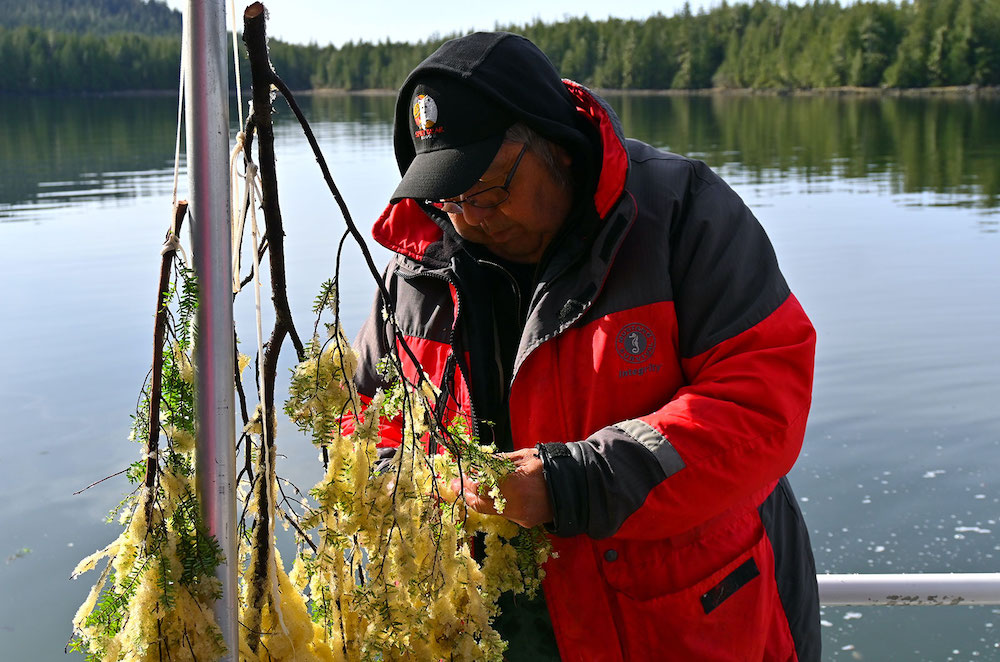
Kitasoo Xai’xais laws say there should be no noise and no blood in the water during herring spawning season. These will scare off herring, Haay-maas says. No fast boats, no shouting, no hunting.
As the boat pulls close to the third set of buoys a hush falls over the crew. The water is teal here, and the silvery bodies of herring occasionally break the surface along the rocky shore.
The spawn is still happening.
Haay-maas turns around and whispers, “Let’s get out of here!” The boat slowly turns around and putts away.
Declaring Kitasu Bay a Marine Protected Area isn’t a decision the nation came to lightly, says chief councillor and Kitasoo Xai’xais Stewardship Authority director Doug Neasloss. The Kitasoo Xai’xais Nation were involved in negotiations with the provincial and federal government for 20 years first, trying to create a co-governance model, but it never worked out.
During that time the province created the Kitasoo Spirit Bear Conservancy and government, First Nations and industry created the Great Bear Rainforest Agreement for logging. For the latter, Neasloss says the nation signed over 15 per cent of its territory but was then shut out of management.
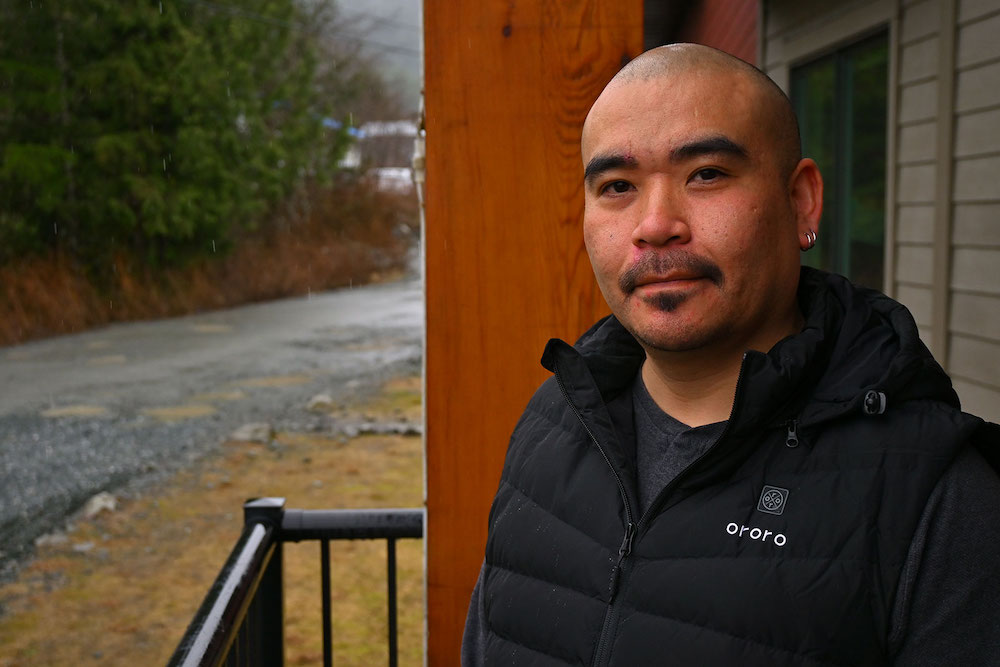
Historically, he says, Indigenous people were also locked out of the Fisheries Act and Oceans Act, too.
“We’ll never lock ourselves out of management again,” Neasloss says.
“Our job is to make sure we’re taking care of our territory and stewardship responsibilities and we'll continue to assert those stewardship responsibilities. Whatever Marine Protected Area is going to be out there we’re going to involved.”
This means the ability to write their own laws into management plans and then have the ability to patrol and enforce that plan, he says.
The Kitasoo Xai’xais enforcement plan is enacted in part by the Coastal Guardian Watchman program, where local Indigenous rangers patrol their territory by sea and air, under authority granted by the nation’s Hereditary Chiefs.
This authority has also been recognized by the B.C. government. As part of a pilot project launched June 2022, Kitasoo Xai’xais watchmen also have provincial Park Ranger authorities, so they can write tickets under the Park Act and Ecological Reserve Act.
By writing their own management plan they can include Kitasoo Xai’xais laws around the herring spawn, Neasloss says, such as the law about no noise and no blood in the water during the herring spawn; by contrast, provincial and federal laws never mention noise or blood.
“The law is not just Canadian law — there’s Kitasoo Xai’xais law, there’s Indigenous law,” he adds.
Neasloss says staff from BC Parks, Parks Canada and Fisheries and Oceans Canada, commonly known as DFO, patrol Kitasoo Xai’xais territory a couple of times a year. Without boots on the ground — or on the water — it sometimes feels like the only protection offered by the government is a stamp on a sign that sits in the woods, he says.
By contrast, Kitasoo Xai’xais Nation has been protecting Kitasu Bay from industry for 50 years.
In the 1970s the province opened Che’gas, also known as Kitasu Hill, for logging, Neasloss says. “The Chief told the company, ‘over my dead body will you log that mountain.’”
In 2013, after the herring fishery had been closed due to low fish count for a decade, DFO opened the fishery against the advice of the community. So the Kitasoo Xai’xais contacted every fisher and told them it didn’t matter what DFO said — Kitasu Bay was closed. It came down to a standoff between fishers and the community, with the commercial fleet floating just outside of the bay. Neasloss says Indigenous communities along the coast were on standby, ready to mobilize if commercial fishers ignored Kitasoo Xai’xais sovereignty and entered the bay.
Despite these efforts, many species are in decline in Kitasu Bay, driven down by human impacts from outside their territory.
During the herring season, the area sees a temporary boost in visiting species — what Liam Ragan, provincial co-ordinator of Important Bird and Biodiversity Areas with BC Nature, says is “the most birds we’ve ever seen as professionals.”
He’s spending a month in Klemtu, surveying how many and what kind of birds come to town for the herring spawn feast.
“It’s insane,” he adds — but definitely not a good sign. The lack of herring elsewhere means birds are being funnelled into smaller and smaller places, searching for food, he says.
Herring spawns used to happen along the entire coast but now they are only found in places where First Nations were able to exercise their sovereignty and stewardship abilities and protect biodiversity, Ragan says.
‘You put us in a situation where there’s nothing left’
Haay-maas says the day that pushed him over the edge was when commercial fishers set their nets between trees he’d set for herring roe harvest, and cut both his anchors so everything sank and wasn’t able to be harvested.
That takes food away from the community.
Haay-maas says he told DFO officers, “I’ll do anything it takes to protect what I have in the water.”
And so they declared Kitasu Bay a Marine Protected Area, implementing their own management plan and closing the area to commercial harvest.
“We’ve closed Kitasu Bay and it’ll stay closed until we can rebuild it. You put us in a situation where there’s nothing left,” Haay-maas says.
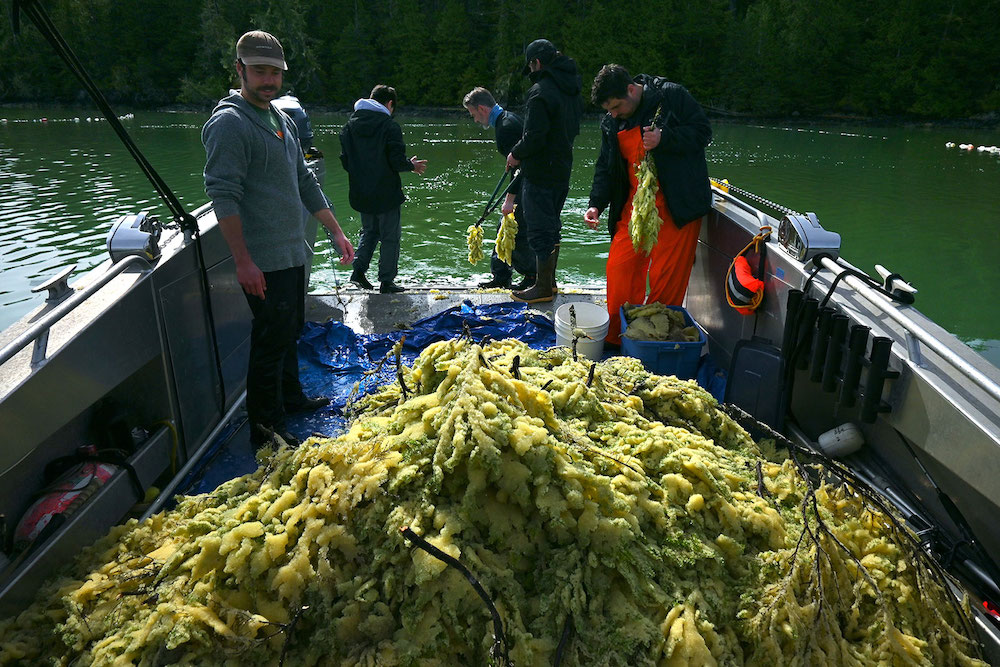
The community must now decide on how best to protect Kitasu Bay for future generations without stifling today’s harvests and economy.
It’s a problem Isaiah Robinson, the general manager of the Kitasoo Development Corp., spends a lot of time thinking about.
Robinson calculates Klemtu’s gross domestic product to be around $3 million. The town’s three main employers are Mowi, a multinational aquaculture company that farms salmon, the Kitasoo Xai’xais Stewardship Authority, which manages, plans for and protects the nations’s lands, waters and resources, and Spirit Bear Lodge, where tourists can stay and take wildlife tours from August to October.
The bears hibernate during the winter and during the spring they’re busy eating, fattening up and mating, says Heather Robinson, a guide with the lodge. During that time, you don’t want to disturb them or frighten them away, she adds.
One goal of the lodge is to employ all locals for its 30-odd staff positions, Heather Robinson says. And it’s making good headway, but the seasonality of the work can be hard.
The community’s location, on Swindle Island, an 11.5-hour BC Ferries’ ride away from the northern tip of Vancouver Island, also makes it difficult to develop the town’s economy, Isaiah Robinson says.
That’s why they need the fish farm, he adds. Mowi’s business brings in around $1.7 million — more than half of the town’s total economy.
Ask around town what people think about the fish farm and you’ll get mixed answers. People worry about the health of wild salmon but value the jobs created by the farm.
When the town’s cannery was shut down after the 1969 collapse of the Atlantic cod fishery, it was “traumatic,” Isaiah Robinson says. He worries if the federal government pulls fish farms out of B.C. waters, which it has said it will do by 2025, it could set the community “back 40 years.”
Robinson wants to explore what other industries could be brought to town. Some logging is possible, but the area that is allowed to be logged is just six per cent of the land base in Kitasoo Xai’xais territory — and it has to be kept out of view from tourists, who value the pristine landscape. Maybe the herring roe-on-kelp fishery, where herring are trapped in a large pen in the sea while they spawn and then are released, could be scaled up, he adds.
All businesses operating within Kitasoo Xai’xais territory have to get a permit from the nation, which allows the community to evaluate the business, how many people they'll bring, what reputation the company has and their willingness to work with a First Nation.
The Coastal Guardian Watchmen enforce the permits.
The lack of local provincial and federal patrols is “super frustrating,” Neasloss says. “They continue to pump out these permits in our territory and no one is here to babysit. That's a challenge.”
Coastal Guardian Watchmen, on the other hand, tour the entire territory by boat every five days and once a week by seaplane, logging all the boats they see in a central database. From April to October, five watchmen use two boats to work in five-day shifts, spending five days out on the land and one day in town, then rinse and repeat.
Mostly the job involves talking to tourists or sports fishers about respecting wildlife and conservation areas, says Ivan Robinson, the nation’s youngest watchman at 19-years-old. But the watchmen are allowed to board boats and ask fishers to show them what they caught and what gear they’re using, he adds.
The watchmen also play a critical role in emergencies. They’re trained as the coast guard, spill response, search and rescue — “basically anything someone could need on the water near Klemtu,” Ivan Robinson says.
Robinson has been training for three years to be a watchman. It takes one year to learn the territory and its expansive winding fjords. A second to learn where all the underwater hazards are, and a third to learn to drive the boat and work with passengers.
Divvying up the harvest
It is Ivan Robinson who pilots the boat as we turn back towards Klemtu from Kitasu Bay. The bow of the boat is piled a metre and a half high with roe, clumped so thickly onto hemlock branches it's hard to make out their pale green needles.
The landscape shifts from a calm open bay to choppy whitecaps as we turn down a channel. The boat carves a snake-like path to avoid dozens of logs bobbing along, dragged through the narrow waterways by an ocean current that pushes and pulls like a river, changing directions twice daily.
When we pass the fish farm, an older Guardian Watchman shakes his head.
“Get it out of here,” he says. “Sure it brings jobs and money — but it’s dirty money.”
A couple minutes before we hit town, Ivan Robinson calls out using the onboard radio that we’ll soon be docking with a boat full of roe. He invites the community to come pick up what they want.
The community comes slowly, arriving by car, on foot and even by ATV. People bring large Rubbermaid tubs, tarps, wagons and shopping bags. They swap recipes (raw with a bit of soy sauce; dipped in a just-boiling pot of water with some eulachon grease and eaten hot; cooked with garlic butter) and divvy up piles to take to elderly relatives.
Over and over people say, “Oh I don’t need more, it’s just for me,” or “That’s enough for me, but I can take that to my grandma.” It is a bounty that people the community share amongst themselves freely, ensuring everyone has what they need. The pile slowly dwindles.
This is the first of many boats that will bring the herring roe harvest into town. The second boat chugs past, heading to a dock half a kilometre down the road, its champagne-coloured heap of roe visible from the shore.
Refuges for bird populations
Chief councillor Neasloss says the Kitasoo Xai’xais are looking at ways to declare their entire territory an Indigenous Protected Area.
One way to do that under Canadian law would be apply for the area to be designated as a National Marine Conservation Area Reserve, which would have the strongest protections and ensure the most Indigenous management, Neasloss says. This is the protection used by the Haida Nation with Gwaii Haanas, at the southern tip of Haida Gwaii.
Gwaii Haanas was declared a Haida Heritage Site in 1984. The federal government then joined the nation to create a co-management strategy, he says. While the two parties disagree on title, they work together to manage the site.
Neasloss says declaring their entire territory an Indigenous Protected Area would unite the scattering of marine areas that have a variety of protections and ensure the nation’s involvement in future management of their territory.
Neasloss shows me a map created through community consultations, where they asked locals to identify the locations they used to harvest specific foods. A warm colour splashes across the map to show where folks harvest herring roe. Then the places where they harvest halibut are overlaid, then urchin, then seagull eggs, then seal. Before long the entire map is red — there isn’t anywhere that doesn’t provide food for the community.
How do you choose just one point to protect?
It’s vital to protect Kitasu Bay and other parts of the territory to ensure non-human life has a refuge, says BC Nature’s Ragan.
Ragan and Kaiden Bosch, a field technician doing bird counts with Ragan for the month, are known around town as “the bird guys.” They’re rarely without a pair of binoculars and have a tendency to break off halfway through a sentence to admire a passing seagull.
I tagged along with them during one survey where, from a moving, bobbing boat and weather that shifted from sunny skies to snow every 20 minutes, they identified 12,727 surf scoters, 5,000 short-billed gulls, 1,983 glaucous-winged gulls, 359 red-breasted mergansers, 70 Barrow’s goldeneye, 195 bald eagles and hundreds of 36 other species.
Later in the month they counted 42,007 surf scoters in a single day, which Ragan calculates to be almost nine per cent of the total global population.
This is Ragan and Bosch’s second-ever herring season in Klemtu. Last year they came for one day and counted 26,000 short-billed gulls, 22,000 surf scoters and 16,000 Thayer’s gulls.
Once they can come back for a third year they’ll have enough data to allow the nation to apply to have the area recognized as an Important Bird Area, which comes with international recognition — though no legal protections, Ragan says.
“Getting these counts on the global ornithological radar is really key to getting them to listen to what nations are saying: that these sites can’t be over-fished, that they can’t be depleted, that they have to be protected because they’re significant to communities, wildlife and from an ornithological perspective to these huge global bird populations,” Ragan says.
Birds can migrate for up to thousands of kilometres twice a year. Unless you keep spaces for them to rest, recover and fatten up along their journey they won’t make it, Ragan says.
Re-seeding the territory with local species
One way to bring together ecological and economic goals in the area could be to turn the entire territory over to local aquaculture once it’s declared an Indigenous Protected Area, Haay-maas says.
This could restore the bay, get the community back to self-sufficiency, ensure people don’t have to leave the community in search of work, and let Canada do some reconciliation in the process.
To do this, he wants to remove the Atlantic salmon farms, which introduce disease and devastate wild fish populations — which then harms eagles, whales and bears, who go hungry. This hurts the tourism industry.
It’d be better to “seed” the territory with local species, helping restore historic populations, he says.
They could focus on wild salmon, abalone, scallops, sea cucumber, herring roe, herring, geoducks, eulachon, urchins, rock cod, lingcod, seagull eggs, kelp, halibut and red snapper, he says.
“Inflation is driving food prices up. We know how to keep our freezers full. All this food comes back if you look after it.”
Younger populations could be reintroduced to the taste of abalone, which hasn’t been eaten for 33-odd years due to low populations, and the smell of a eulachon grease boil, which similarly only lives in Elders’ memories.
Meanwhile Canada could help by rebuilding the community’s infrastructure. The government could restore the community’s ability to look after itself by helping them obtain boats and fishing gear, and educate people on how to use them.
Reconciliation means setting people up for success, not just handing things over, he says.
The federal government could also do more to protect the territory from the risk of an oil spill from a tanker, he says. “They’re a threat to our ability to gather traditional foods and could destroy our traditional territory all in one go.”
Meanwhile, as today’s herring roe harvest winds down, community members disperse from the docks.
This evening families across town will sit together, “peel” the roe off the hemlock branches and kelp, and preserve the food in their freezers.
It’s a good harvest year, providing food for the community and food for freezers — a feast signalled by the spilling of the moon and the tops of skunk cabbage pushing up through the chilly spring earth. Calling birds, whales, wolves and bears from their winter lands. And feeding Kitasoo Xai’xais with a harvest they’ve known since time immemorial, and are working hard to protect.
Reporting and travel expenses for this article and series were funded by the Institute for Journalism & Natural Resources and the Gordon and Betty Moore Foundation. The Tyee maintains editorial control. Read the first part of this two-part series, which explores how how First Nations are asserting sovereignty over their lands and waters. ![]()
Read more: Indigenous, Food, Environment


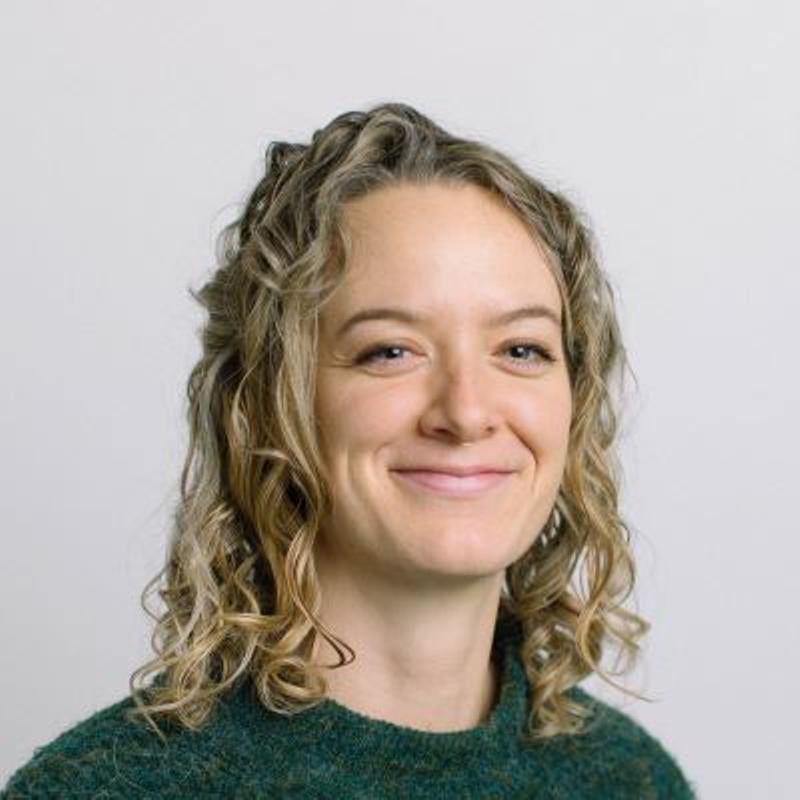













Tyee Commenting Guidelines
Comments that violate guidelines risk being deleted, and violations may result in a temporary or permanent user ban. Maintain the spirit of good conversation to stay in the discussion and be patient with moderators. Comments are reviewed regularly but not in real time.
Do:
Do not: